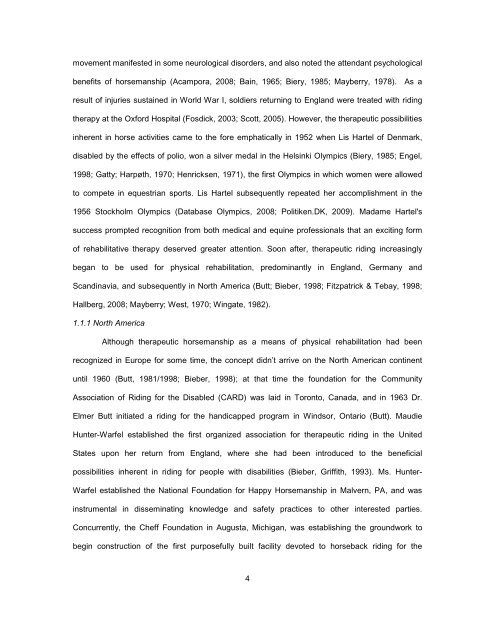A SYSTEMATIC REVIEW OF THE EFFECTS OF PSYCHOTHERAPY ...
A SYSTEMATIC REVIEW OF THE EFFECTS OF PSYCHOTHERAPY ...
A SYSTEMATIC REVIEW OF THE EFFECTS OF PSYCHOTHERAPY ...
You also want an ePaper? Increase the reach of your titles
YUMPU automatically turns print PDFs into web optimized ePapers that Google loves.
movement manifested in some neurological disorders, and also noted the attendant psychological<br />
benefits of horsemanship (Acampora, 2008; Bain, 1965; Biery, 1985; Mayberry, 1978). As a<br />
result of injuries sustained in World War I, soldiers returning to England were treated with riding<br />
therapy at the Oxford Hospital (Fosdick, 2003; Scott, 2005). However, the therapeutic possibilities<br />
inherent in horse activities came to the fore emphatically in 1952 when Lis Hartel of Denmark,<br />
disabled by the effects of polio, won a silver medal in the Helsinki Olympics (Biery, 1985; Engel,<br />
1998; Gatty; Harpøth, 1970; Henricksen, 1971), the first Olympics in which women were allowed<br />
to compete in equestrian sports. Lis Hartel subsequently repeated her accomplishment in the<br />
1956 Stockholm Olympics (Database Olympics, 2008; Politiken.DK, 2009). Madame Hartel's<br />
success prompted recognition from both medical and equine professionals that an exciting form<br />
of rehabilitative therapy deserved greater attention. Soon after, therapeutic riding increasingly<br />
began to be used for physical rehabilitation, predominantly in England, Germany and<br />
Scandinavia, and subsequently in North America (Butt; Bieber, 1998; Fitzpatrick & Tebay, 1998;<br />
Hallberg, 2008; Mayberry; West, 1970; Wingate, 1982).<br />
1.1.1 North America<br />
Although therapeutic horsemanship as a means of physical rehabilitation had been<br />
recognized in Europe for some time, the concept didn’t arrive on the North American continent<br />
until 1960 (Butt, 1981/1998; Bieber, 1998); at that time the foundation for the Community<br />
Association of Riding for the Disabled (CARD) was laid in Toronto, Canada, and in 1963 Dr.<br />
Elmer Butt initiated a riding for the handicapped program in Windsor, Ontario (Butt). Maudie<br />
Hunter-Warfel established the first organized association for therapeutic riding in the United<br />
States upon her return from England, where she had been introduced to the beneficial<br />
possibilities inherent in riding for people with disabilities (Bieber, Griffith, 1993). Ms. Hunter-<br />
Warfel established the National Foundation for Happy Horsemanship in Malvern, PA, and was<br />
instrumental in disseminating knowledge and safety practices to other interested parties.<br />
Concurrently, the Cheff Foundation in Augusta, Michigan, was establishing the groundwork to<br />
begin construction of the first purposefully built facility devoted to horseback riding for the<br />
4
















